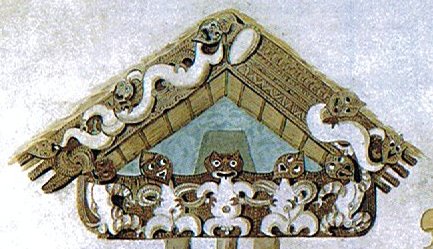|
3. If Rigel is straight above at midnight we might think that 6 hours later (a quarter of 24) it will be at the horizon in the east - rise heliacally. As I have argued earlier the right time to observe the stars should be when they cross the meridian above (and not the horizon) and midnight ought be the best time, when it is completely dark. However, a star at zenith will march towards the west instead of towards the east. This means that when Rigel is straight above at midnight it will be at the horizon in the west at dawn. If Rigel is rising heliacally it will be together with Sun all day and all night through. It cannot be seen at midnight because then it is with Sun at the other side of Earth. We have arrived at the probable origin of the nakshatra method (cfr at Camp 5). To ascertain that Rigel will rise heliacally at dawn we should at midnight observe a star which is at the opposite side of the sky. Rigel at hanau in the G text presumably implies its opposite star is at the meridian at midnight.
6 hours later Rigel would then be at noon and its opposite (nakshatra) star would be descending at the horizon in the west. The star opposite to Rigel should have right ascension 05h 12m (Rigel) + 12h = 17h 12m, which we can translate into (17 * 60 + 12) / 1440 * 365.25 = 261.8 days after autumn equinox (on Easter Island) or to glyph number 262 - 64 = 198:
However, it feels a bit awkward to look ahead from line a1 to line a7 in order to find the nakshatra star of Rigel. Midnight comes before dawn and the natural way to look should not be ahead in the text but backwards. Hau tea in Ga7-28 is 198 - 14 = 184 glyphs beyond Rigel (I have decided to see the star in Ga1-13) and maybe we should instead count 184 - 14 = 170 and 472 - 170 = 302:
I prefer this way of reading the text because the takaure season (Gb3-1) is beginning here - the opposite of the season which Rigel initiates. In addition Gb3-11 is a day of Saturn (in contrast to Rigel in a day of Mars). Mars implies spring and Saturn implies the end of Sun's presence. Beyond Gb3-22 we have a π glyph, cfr at The Paw Held High:
From Rigel to Regulus there are ca 75 (a quarter of 300) days (153.7 - 79.1 = 74.6). Once Leo was at midsummer (north of the equator) and he was the king of 'land'. Since then - about (154 - 90) * 72 = 4600 years ago - he has been on the sloping path down towards fall. Or maybe he was beheaded at his apex and succeeded by a little offspring person (cfr at The Queen of Hearts):
Essential is to understand that Sun in the tropical belt has a pair of cycles in the year - he is passing overhead twice a year. Therefore, if he rules for 10 * 30 = 300 days in a year we should have a pair of cycles with 150 days, and day 75 is the central day in such a cycle. By the way, there is a star of prominence at 17h 12m, viz. Ras Algethi (α Herculi) - 'the head of a kneeling man'. This is how Hevelius has drawn the constellation:
|
||||||||||||||||||||||||||||||||||||||||||||||||||||||||||||||||||||||||||||||||||||||||||||||||||||||||||||||||





















